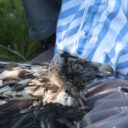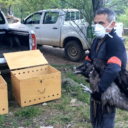An important workshop for the conservation of vulture populations in Europe, Central Asia and the Middle East will take a place from the 25th to the 29th of October 2016 in the National Park of Monfragüe (Spain). More than 70 participants from 25 countries and from over 50 different organizations will gather to discuss priorities for vulture conservation in order to prepare the European component of the Multi-species Action Plan to conserve African-Eurasian Vultures (Vulture MsAP).
In November 2014, Parties to the Convention on Migratory Species (CMS) adopted a resolution to develop a Multi-species Action Plan to Conserve African and Eurasian Vultures (Vulture MsAP), under the auspices of the Memorandum of Understanding on the Conservation of Migratory Birds of Prey in Africa and Eurasia (Raptors MoU).
The overall aim is to develop a comprehensive strategic Action Plan covering the whole geographic ranges (at least 124 countries) across Africa, Asia, and Europe of 15 species of Old World vultures to promote concerted, collaborative and coordinated international conservation actions.
The Vulture Conservation Foundation (VCF) is responsible for the European component (including Central Asia and the Middle East), which includes the organization of the European Workshop. Target species in this workshop are the four European vulture species (Bearded Vulture (Gypaetus barbatus), Egyptian Vulture (Neophron percnopterus), Cinereous (Black) Vulture (Aegypius monachus) and the Griffon Vulture (Gyps fulvus))
The main threat to vultures worldwide and the current limiting factor for their recovery is the use of poison (normally pesticides) to kill predators or other wildlife, with vultures being the collateral victims. Veterinary drugs are also a threat, and the approval in Europe of a veterinary anit-inflammatory drug Diclofenac, extremely toxic to vultures, and that caused the massive vulture population collapse in Asia, is extremely worrying.
Other threats include habitat loss, decreasing food availability, fragmentation of remaining populations, direct persecution, human disturbance, collisions with infrastructure such as wind turbines and power cables, and electrocution on electricity poles.
Selecting Extremadura as a meeting point for this important vulture event is not a coincidence. Extremadura is one of the most important vulture areas in world, holding impressive population of Cinereous (Black) Vultures (900 breeding pairs), more them 3000 Griffon Vulture pairs and about 170 pairs of the Endangered Egyptian Vulture. It is always pleasant talking about vultures having them around.
The workshop is financially supported by the CMS Coordinating Unit of the Raptors MoU and also counts with contribution from the Spanish authorities: Diputación de Cáceres, Dirección General de Turismo, Dirección General de Medio Ambiente from the Junta de Extremadrua (Regional Government of Extremadura) and the National Park of Monfragüe.






